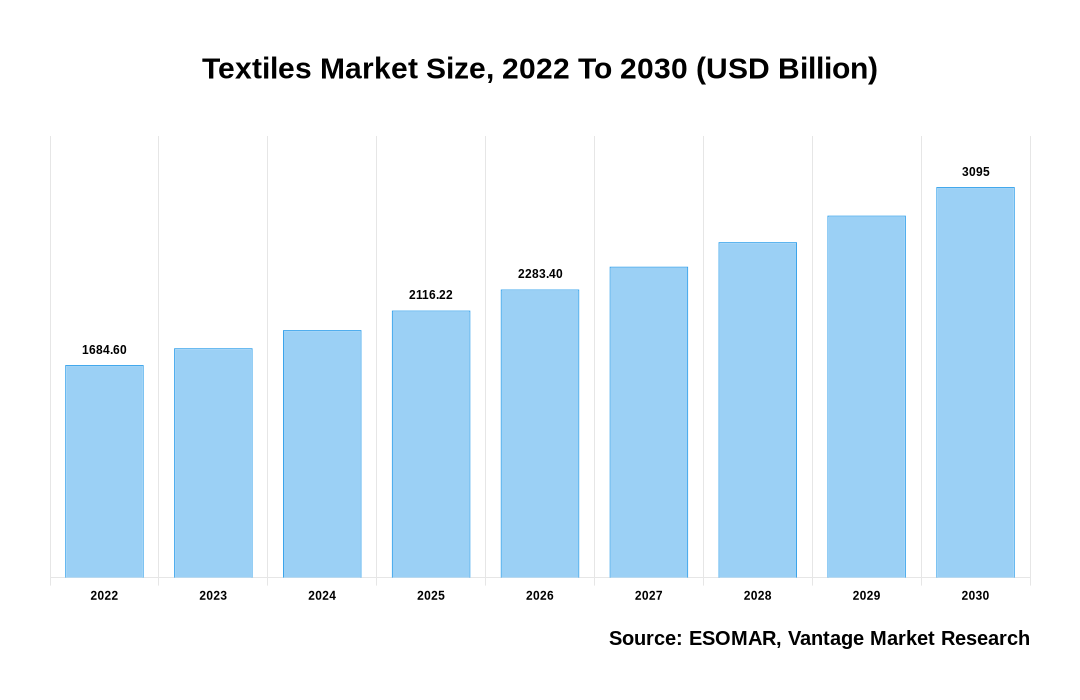Global Textiles Market
As stated in our extensive report; the Global Textiles Market accounted for USD 1684.6 Billion in 2022 and is projected to reach a value of USD 3095 Billion by 2030.
The worldwide economic system closely relies on the Textiles industry, which is vital for employment and displays its diverse nature. The Textiles industry has experienced extensive growth in recent years because of factors like the expanding worldwide populace, particularly in rising economies. This has caused a higher demand for Textiles and clothing, as they may be crucial commodities that meet basic needs worldwide. Additionally, the rise in disposable income, particularly in developing economies, has boosted the Textiles marketplace as people have extra purchasing electricity to spend on high-quality and elegant clothes.
The ever-changing fashion industry heavily affects the increase of the Textiles market. Consumers are increasingly fashion-conscious, leading the industry to innovate to satisfy evolving fashion choices continuously. Manufacturers are diversifying their offerings, employing both natural and synthetic fibers to cater to these converting tastes. E-commerce platforms are significant in connecting clients with various clothing options, providing a convenient avenue for marketplace increase. Simultaneously, technological improvements such as 3D printing, digital printing, and intelligent Textiles are revolutionizing the industry.
Click To Get a Free Sample On the Research Study

Sustainability is becoming increasingly essential in shaping the growth of the Textiles industry. Heightened awareness of environmental issues leads consumers to prioritize eco-friendly alternatives, resulting in a growing demand for sustainable Textiles like organic cotton, recycled fabrics, and eco-friendly dyes. Manufacturers are responding by adopting sustainable practices to fulfill consumer preferences and tap into the expanding market for environmentally conscious Textiles.
Key Factors Influencing Global Textiles Market Growth
The growth of the global Textiles market can be attributable to the following:
- The developing population and rising disposable incomes have led to a considerable growth in consumer demand for Textiles globally. This has directly contributed to the growth of the Textiles market.
- Continuous technological advancements have revolutionized the Textiles industry. The adoption of automated manufacturing processes, development of innovative fabrics, and advancements in digital printing techniques have not best increased production efficiency but also enhanced the overall quality of Textiles products, driving market growth.
- Growing issues about the environmental impact of Textiles have led to a shift towards sustainable and eco-friendly practices in the industry. consumers are increasingly demanding Textiles made from organic or recycled materials, as well as products that adhere to ethical manufacturing processes. This shift has encouraged manufacturers to adopt sustainable practices, leading to market growth.
- The globalization of the Textiles industry has significantly influenced market growth. Manufacturers are increasingly outsourcing production to countries with lower labor costs, permitting them to provide competitive pricing. Additionally, free trade agreements and reduced trade barriers have facilitated the movement of Textiles products across borders, expanding market reach and driving growth.
Asia Pacific Region to Express the Largest Market Growth
Asia Pacific is accounted to have the most significant market growth in 2022. This dominance is due to the region’s robust manufacturing infrastructure, extensive fabric production abilities, and growing customer base. The region’s Textiles market growth is driven by increasing demand for sustainable and revolutionary Textiles as consumers prioritize eco-friendly and ethically produced fabrics. By adopting advanced technologies and evolving consumer choices, the Asia Pacific Textiles market is not only a manufacturing powerhouse but is also shaping the industry’s future.
The Asia Pacific area advantages from a wide range of Textiles applications, including traditional clothing and apparel and technical Textiles used in diverse industries. The integration of smart coatings and advanced functionalities in Textiles aligns with the region’s attention to technological innovation and leads to a higher demand for value-added Textiles products. This shift, combined with the developing middle-class population in countries like China and India, propels the Asia Pacific Textiles market to the leading edge of growth and innovation, attracting industry stakeholders and investors.
Conclusion
Overall, the growth of the Textiles market is due to factors that include a growing population and higher disposable income, evolving fashion alternatives, and technological improvements. Due to the growth in the global population and economic development, the Textiles industry is expected to expand further and provide substantial chances for manufacturers, retailers, and consumers.
Some of the key players in the Global Textiles Market include BSL Limited (India), INVISTA S.R.L. (U.S.), Lu Thai Textile Co. Ltd. (China), Paramount Textile Limited (India), Paulo de Oliveira S.A. (Portugal), Successori REDA S.P.A. (Italy), Shandong Jining Ruyi Woolen Textile Co. Ltd. (China), Shandong Demian Incorporated Company (China), Shijiazhuang Changshan Textile Co. Ltd. (China), Weiqiao Textile Company Limited (China), DBL Group (Bangladesh), B.D. Textile Mills Pvt. Ltd. (India), IBENA Inc. (U.S.), Heytex Bramsche GmbH (Germany), Bahariye AS (Turkey), Fratelli Balli S.P.A. (Italy), İpekiş Mensucat Türk AS (Turkey), Lakhmi Woollen Mills (India), Wilh. Wülfing GmbH & Co. KG (Germany) and others.
![[Market Research Reports] – Research Google News Blog | VMR.Biz](https://www.vmr.biz/wp-content/uploads/2022/12/logo-removebg-preview.png)











